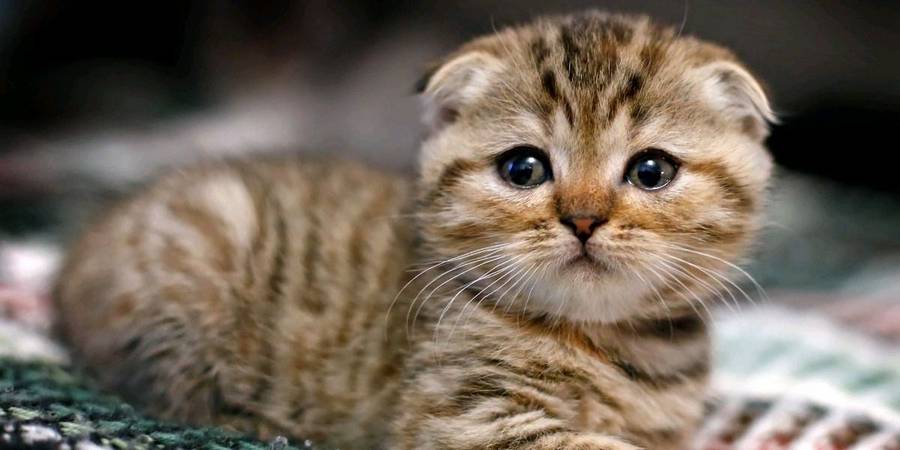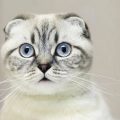If you ask what color Scottish cats are, the answer is that gray (the color among Scottish cat breeders is called blue). This is a common color of Scottish cats. But today the variety of colors is very large. So, when asked what are the colors of Scottish cats, you should boldly answer: any! To get such a wide palette, Scottish cats had to be crossed with other breeds. Today, cross-breeding is not welcome, because they already have the necessary set of genes.
In this article you will find out how the colors of Scottish kittens can change as they grow older, and see the pictures of Scottish cats and kittens of almost all colors and patterns. It is impossible to show absolutely all colors within this article, because there are so many of them, and genes, combined in weird ways, still amaze Scottish cats breeders.
The colors of Scottish cats are divided into the following groups: solid color, bi-color, pointed, tabby, smokey, van, harlequin, shaded, chinchilla, parti-color and ticked. It does not depend upon the type of breed. Such colors can be the same for Scottish folds, Scottish straights, Hyland folds, and Hyland straights.
Solid Colors
Solid or monochrome color means, that there is no inclusions of other colors. Shade is pure, should be rich and smooth along the whole length of the hair. If there are inclusions of other colors, it is either another color or a defect, which reduces the price of a kitten and reduces the rates at shows. Solid colors include blue (what people call gray), black (Ebony), white, brown (chocolate), lilac, fawn, cinnamon, red, and cream. Until recently, blue was considered a classic: these cats were the majority. Today, however, this is no longer the case. Nevertheless, black, white, chocolate and red Scottish cats are more rare than others.

Black
Color: the coat is solid black, including the undercoat. Sometimes this color of Scottish cats is called ebony.
Nose: black
Eyes: usually gold or copper
Paw pads: black or brown
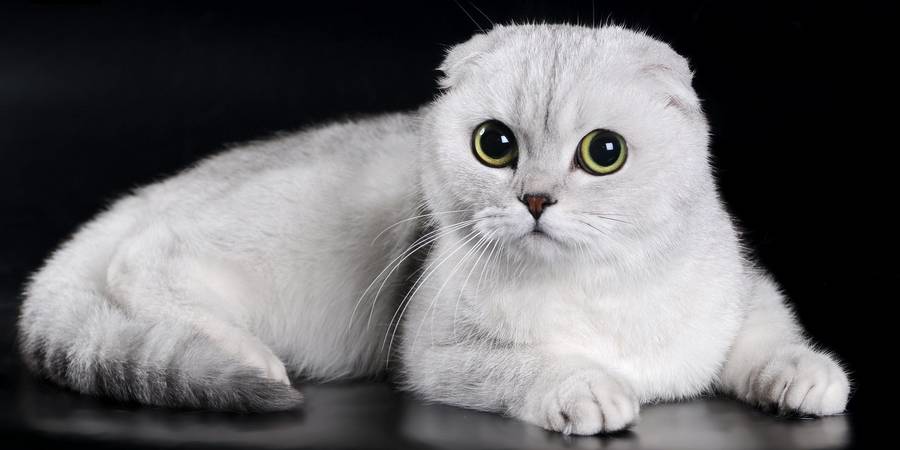
White
Color: pure white
Nose and paw pads: pink
Eyes: usually blue, gold or copper. Cats with eyes of different colors can be found, one of the eyes is usually blue.
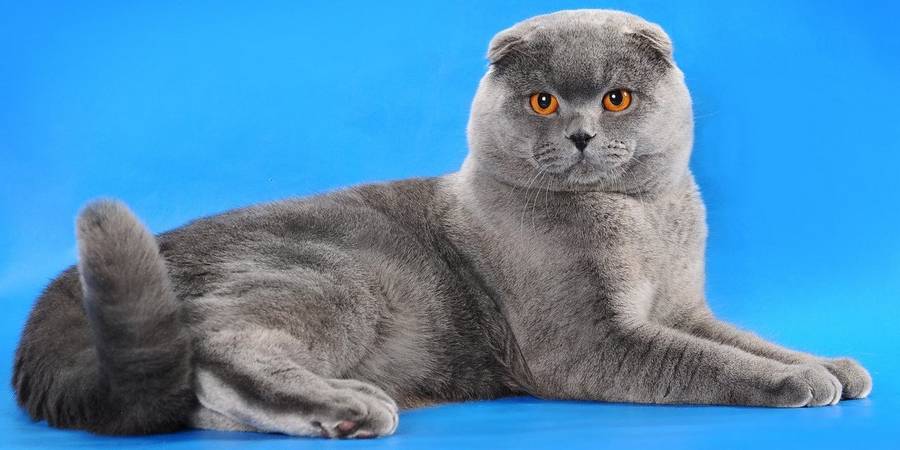
Blue
Color: light and dark shades are allowed. The most common is lighter blue.
Nose and paw pads: blue
Eyes: gold or copper
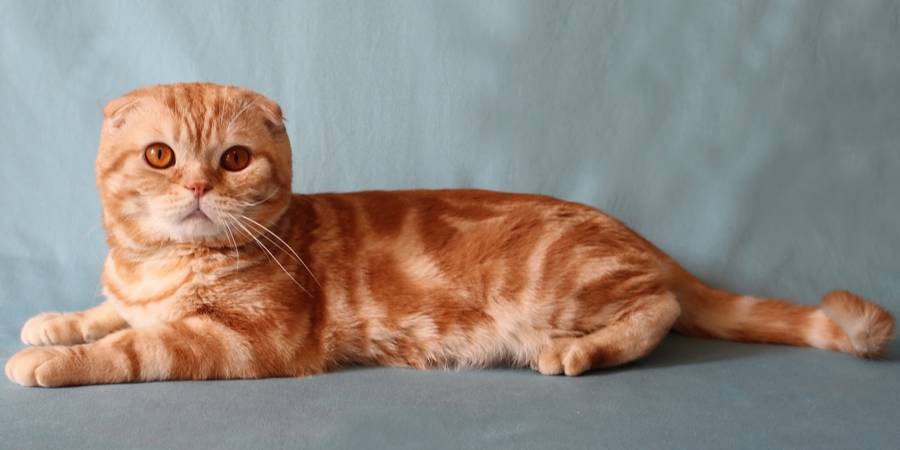
Red
Color: deep red, no change in shades. Muzzle in whole of the same color.
Nose and paw pads: bright red, almost copper
Eyes: gold or copper
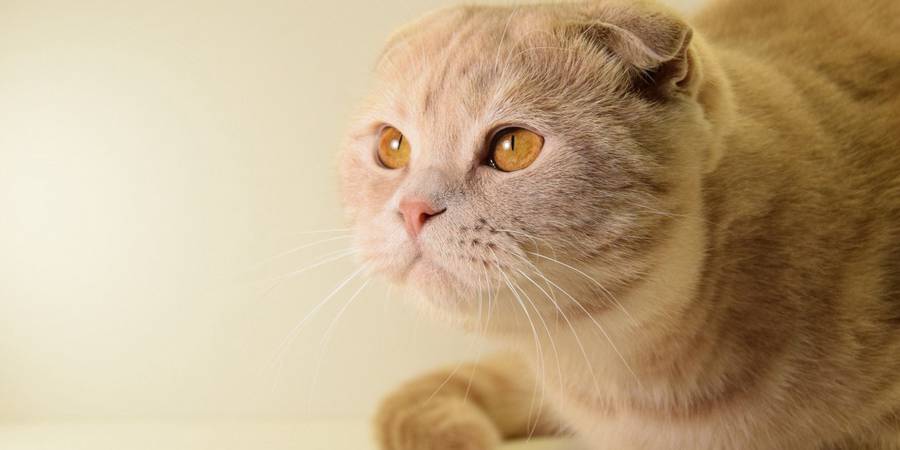
Cream
Color: Different shades of cream are allowed, lighter cream colors are more common. The color should be uniform throughout the body, with no variations.
Nose and paw pads: Pink
Eyes: copper or gold

Chocolate
Color: rich brown, like bitter chocolate, smooth without obvious variations
Nose and paw pads: brown
Eyes: copper or gold

Lilac
Color: cool gray with a pinkish tint
Nose and paw pads: lavender
Eyes: copper or gold
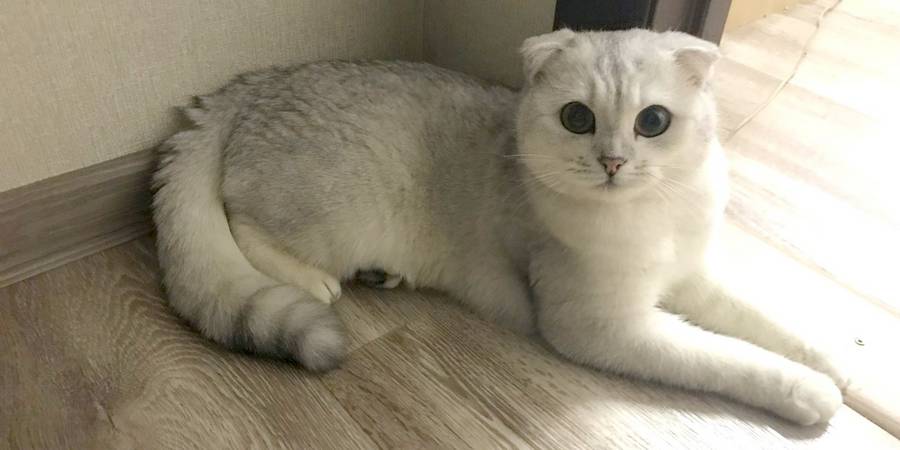
Fawn
Color: milky to beige, equal without contrasts
Nose and paw pads: dark beige or light brown
Eyes: gold or copper
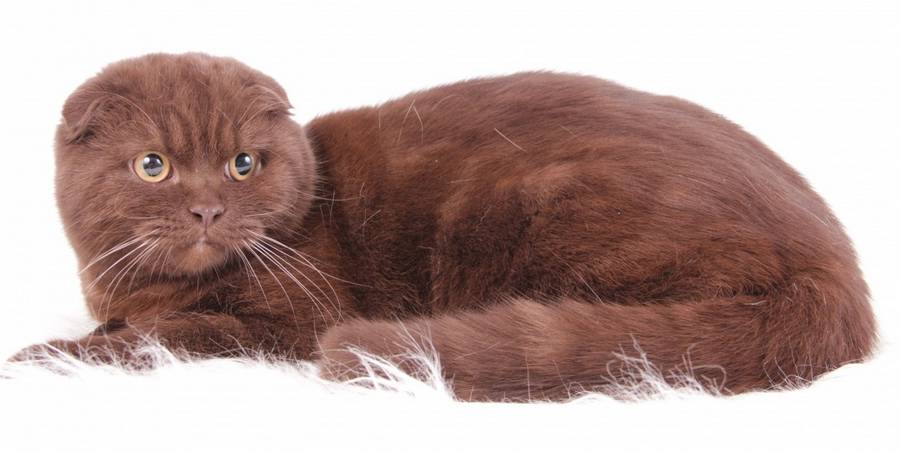
Cinnamon
Color: reddish brown
Nose and paw pads: brown
Eyes: copper or gold
Bicolored
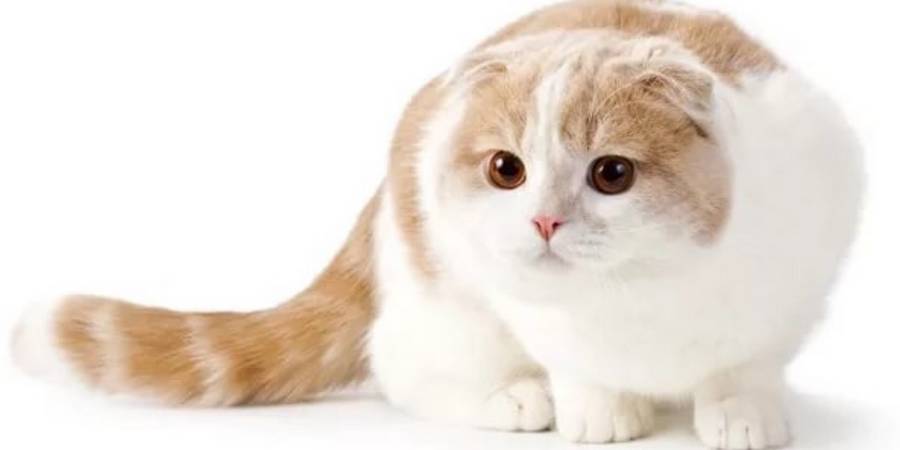
Bicolored is a color of Scottish cats in which half of the coat surface is white and the other half is blue, cream, red or tabby. Preferably, the patterns should be symmetrical.
Pointed

Pointed cats’ bodies should have a basic light tone, while the muzzle, ears, paws and tail are darker. Scottish Point cats can be of several varieties: seal point (light beige body with dark beige markings), lilac point (white body with purple markings), blue point (light body and light blue markings), chocolate point (white body and brown markings), Creme Point (light cream body with cream colored marks), tortoise point (tortoise-like, which combines markings of the main color with red or creamy spots), tabby point (striped marks).
There are also other point varieties. Point color cats are based on an interesting gene which causes the coat to darken in temperature-dependent manner. The parts of the body where the temperature is lower due to poorer blood circulation (paws, muzzle, ears, and tail) produce a darker color.
Parti-Colored
In such a way that a Scottish cat can be called a parti-colored, it must have a combination of dark spots (black, brown, lilac or blue) on its coat with red or cream and even white spots. The spread of these two colors over the body must be more or less equal. Particolor includes several color types, including tortoiseshell and calico. The differences lie in the variation of colors. All recognized solid colors can also be tagged with white. These cats belong in the party-colored group. At cat shows, first of all, evenness and harmony of pigment distribution, as well as intensity, are looked at.
Tortoiseshell
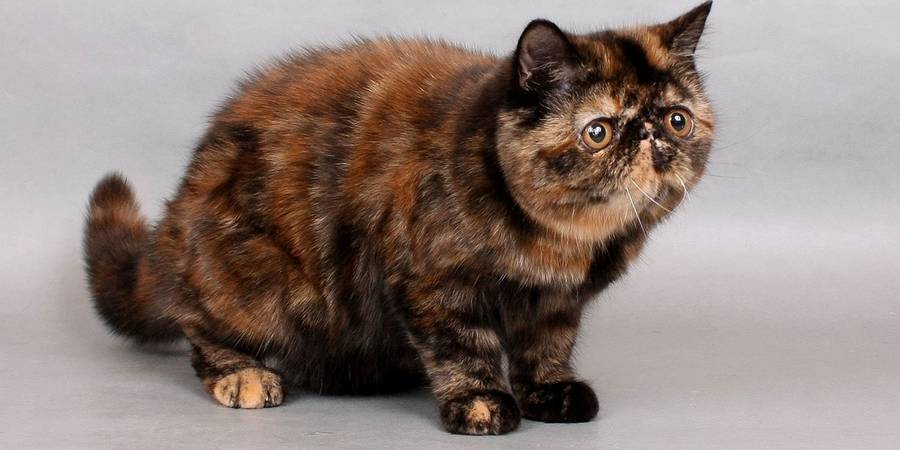
Tortoiseshell colors can be black and red, chocolate and red, blue and cream, and lilac and cream. But the tortoiseshell Scottish cat must not be confused with a tricolor one. It also should be taken into account that only female cats can have tortoiseshell color. If it occurs in a male cat, it is a genetic mutation, indicating an inability to produce offspring.
Calico

Calico color aso belongs to the Parti-colored type. Scottish cats of this color have a combination of tortoiseshell and white color on the coat.
Smokey

This coloring of a Scottish cat should have a solid shade and the base of the hairs should be silver white. That is, part of the length of the hair can be black, for example, but the base will still be silver-white. This unusual hue of each strand of hair is called tipping.
The Smokey belongs to the silver color group and appears under the dominant silver gene. At the smoky coat there should be no pattern, though in some cats it occurs. This color can be confused with solid color, because usually a hair is colored for two-thirds of the length, and if the coat is thick, you need to pull the hairs apart to see the base.
Tabby colors

Scottish tabby cats have a zonal pattern. For example, it can be the letter M on the forehead, light spots on the back of the ear, the outline of the eyes and nose, a swirl pattern on the cheeks, a necklace pattern on the chest, a ring pattern on the legs and tail.
Tabby colored cats are subdivided:
- depending on the type of pattern – into tiger (mackerel), spotted (spotty) and marbled color (shaded);
- depending on color combinations – on silver (silver main color and black pattern), silvery-blue (white main color and blue comments on sides, on muzzle and tail), red (light-red main color and bright red pattern), brown (copper color and black pattern), blue (cream-blue base and bright blue pattern), cream (pale cream base and dark cream or beige pattern), cameo tabby (white color with bright red stripe pattern).
Chinchilla

In chinchilla colors, one-eighth of the hair length is colored, and the rest is white. This effect is called tipiping. Cats of this color are subdivided into the following subspecies: silver chinchilla, golden chinchilla, blue golden chinchilla. The latter is the rarest among chinchillas. These are very beautiful cats. Hence the high prices.
Tipping effect means an unequal distribution of pigment along the length of the coat, in which only the tip of the hair is colored, while the rest of the hair remains white. Tipping is often found in chinchilla and shaded colors. There are different types of tipping, depending on which part of the hair is colored, i.e. how long the colored part is.
Ticked colors

Ticking refers to the uneven coloring of a hair, but not in two different colors, as in tipiing, but in three. Ticking is an evenly zoned coloring with alternating dark yellow rings along the entire length of the hair and a darker top with no trace of pattern. Strips of different color alternate on each hair across it, creating unique shades. Those who do not know about this effect try to describe the tiked Scottish cat with such words as “it has a coat full of different colors,” “the coat has several colors and shades at once,” and so on. For Scottish cats this color is not yet the most common, and tiked cats are expensive.
Shaded
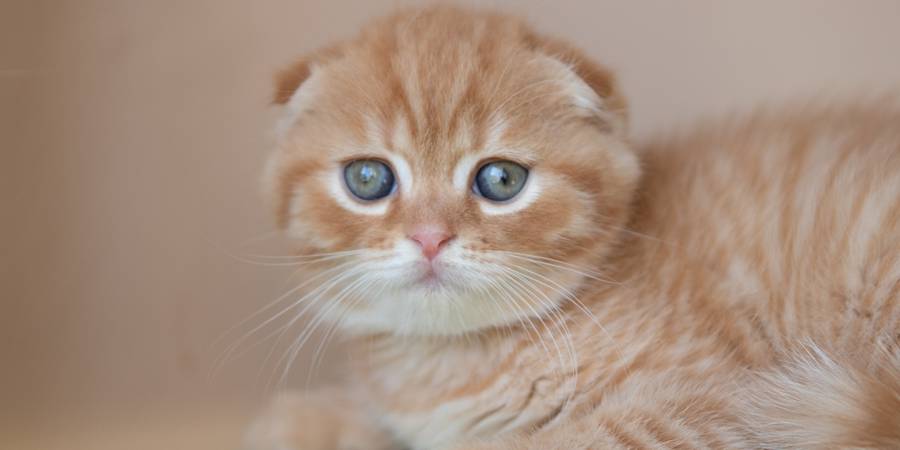
In shaded colors, only the top third of the hair tip is tinted, the rest of the hair is white. Scottish cats of this color have lighter undercoat, shaded hair on the sides, back, ears, head and tail. They have olso lighter colored coat in the chin, belly, and bottom of the tail. Only the upper part of the hair is dyed in any of the basic colors: gold, silver, or red. Shaded colors are subdivided into Shaded Gold, Shaded Silver, Shaded Red. There should be no visible pattern, but the letter M on the forehead and dark ring patterns on the paws are allowed.
Van

Scottish Van cats have a white body except for the tail and muzzle. A few spots on the body and paws are also allowed. The coat on the spots can be not monochromatic, but, for example, tabby.
Harlequin

Harlequins are colored non-white about one-fifth or one-sixth of their body, the spots may be scattered in different places rather than concentrated next to each other. The tail is colored. The rest of the body is white. Such cats do indeed resemble harlequins, hence the name.
Rare colors of Scottish cats
Many people wonder what the rarest and most expensive colors of Scottish cats are. Today it is not a problem to find any color, but among breeders of Scottish cats are very valuable tortoiseshell cats, because they carry both red and black genes at once. Among usual owners, who are not breeding, so called precious colors – gold and silver, are in style now. However, we can no longer call these colors rare, because there are more and more such cats due to their fame
And for those who are searching for what is the best color of Scottish cats, let us say: it is the color that you like, because you have to go live with this cat. Perhaps you will be attracted to cats whose coloring is as close to natural as possible, that is, spotted or striped. Or maybe you will like red cats, because they are pleasant to the eye and raise your spirits with their appearance. Whatever color you choose, the most important thing is that you like it.
A little bit of Scottish cat genetics
Many people are curious to know how breeders achieve the different colors of Scottish cats. There are two dominant genes in Scottish cats that are responsible for black and red coat colors. Each of them can act as a dominant (suppressing weaker genes) and recessive (suppressing gene).And there is a third gene, responsible for the saturation of the pigment. Combined in a certain order, these genes can give absolutely unthinkable colors.
